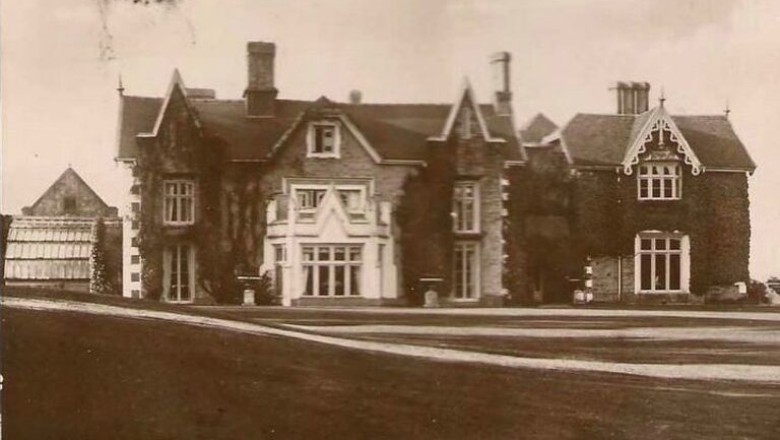
Unsuspecting Couple Discovers Breathtaking Secret Hidden Beneath Their Carpet
Victorian Home
The Victorian property that Kathryn and Phil restored showcased the architectural grandeur of the 1830s. Originally built as a magnificent residence, it bore the features of an era known for its intricate detail and elegance. However, the passage of time and the succession of different owners led to numerous changes to the structure. These alterations, often aimed at modernizing the house, gradually eliminated many of its original features. For Kathryn and Phil, the goal was to undo these changes and restore the house to its original Victorian splendor.
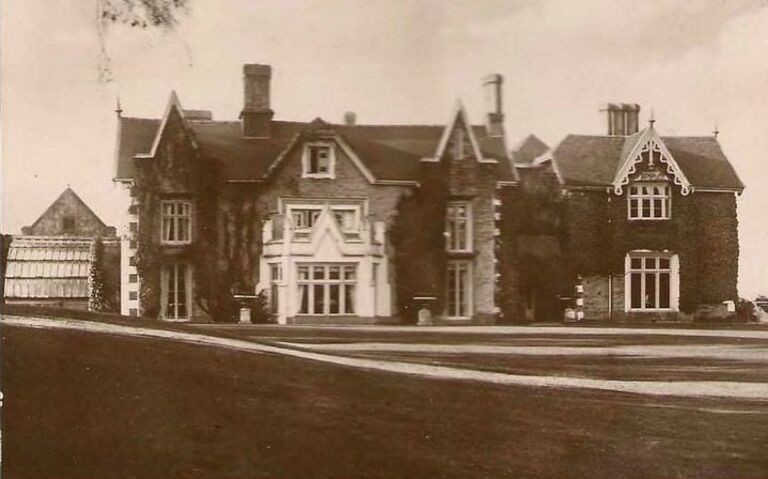
This ambitious project went beyond mere renovation; it was a revival and revitalization. Each step of the process presented its own challenges, from uncovering hidden layers of history to deciding how original features should be faithfully restored or replicated. Their journey was more than just a DIY project; it was a labor of passion and commitment to preserving a piece of historical architecture.
A Stunning Transformation
In August 2019, Kathryn and Phil began sharing their restoration story on social media with a wider audience. Their Instagram account, @totheshireborn, became a digital diary documenting the transformation of their property from a neglected building into a vibrant family home. The followers of their account witnessed a visual narrative that showcased not only the progress but also the dedication and hard work involved.
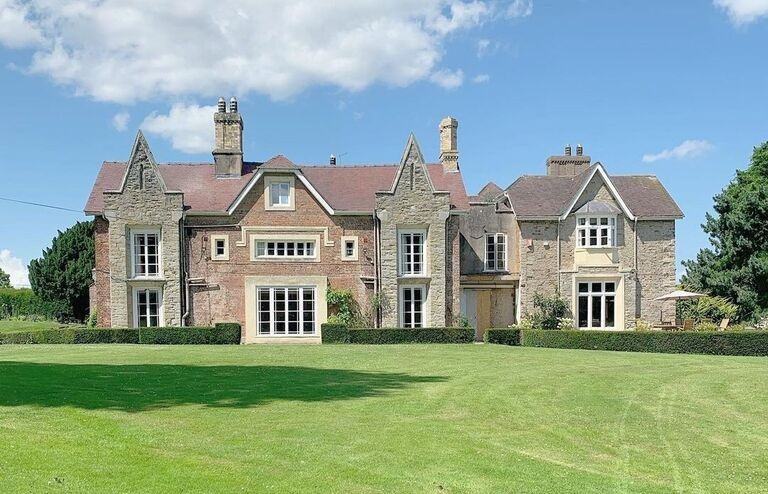
Their photos captured the various phases of transformation, portraying both the challenges and successes. What started as a personal project soon attracted a following of like-minded individuals, restoration enthusiasts, and history lovers, all eagerly anticipating the next chapter in the house's rebirth.
In Awe
A significant moment in their restoration journey occurred in September 2019, marked by an astonishing discovery. As Kathryn shared on her Instagram account, the surprise came when they decided to remove the hallway carpet. What they found underneath was an unexpected glimpse into the house's past, a hidden treasure that had been concealed for years.

Kathryn's reaction, a mix of shock and excitement, reflected the significance of the discovery. This find was not just a physical remnant of the past; it was a connection to the house's history, offering new insights into its original design and the lives of its former inhabitants.
The Beginning of the Journey
When Kathryn and Phil moved into their house in Shropshire in early 2018, their knowledge of its history was limited. They knew that the oldest parts of the house dated back to the 1830s, but much of its past remained a mystery. Their decision to move in and undertake the restoration was driven by the desire to breathe new life into the property, despite their limited understanding of its historical significance.
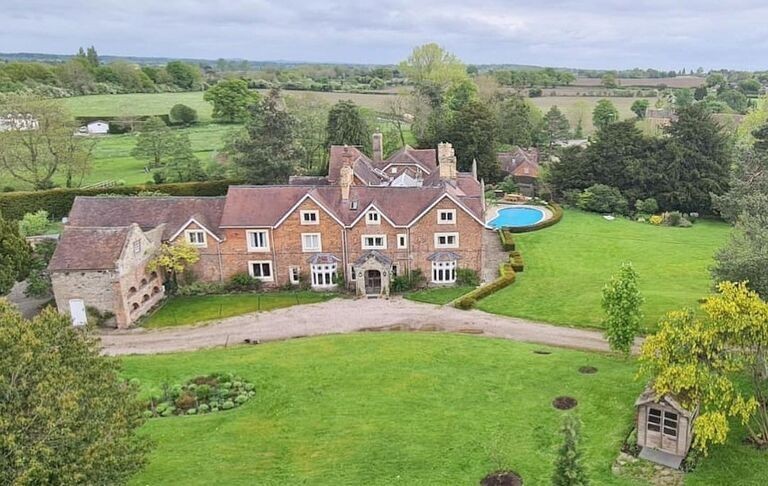
The discovery they made under the carpet was more than just a fortunate find; it was a link to the house's past that they had not expected, a puzzle piece that helped sharpen the focus on the house's history.
Deceptive Appearance
The exterior appearance of the house, as captured in Kathryn and Phil's early photographs, presented a facade that had preserved much of its structural integrity over the years. However, compared to historical images of the property, the extent of the changes became apparent. The house had once featured elaborate conservatories and lush rose gardens that had since disappeared.
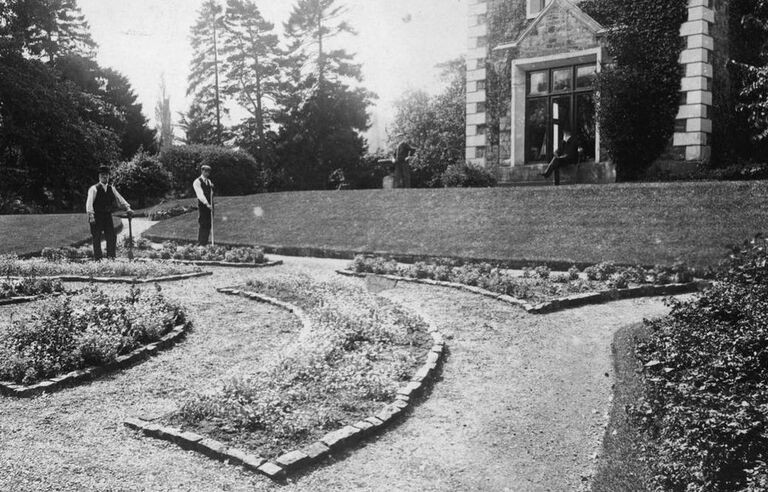
These images served as poignant reminders of the property's former grandeur and the changes it had undergone, underscoring the couple's commitment to restoring its historical charm.
Lack of Heating or Appliances
Inside the house, the influence of time was even more palpable. When Kathryn and Phil moved in, they were faced with a range of typical issues of an old, neglected property. Essential appliances were not functioning, and the absence of central heating posed a significant challenge, especially during the colder months.
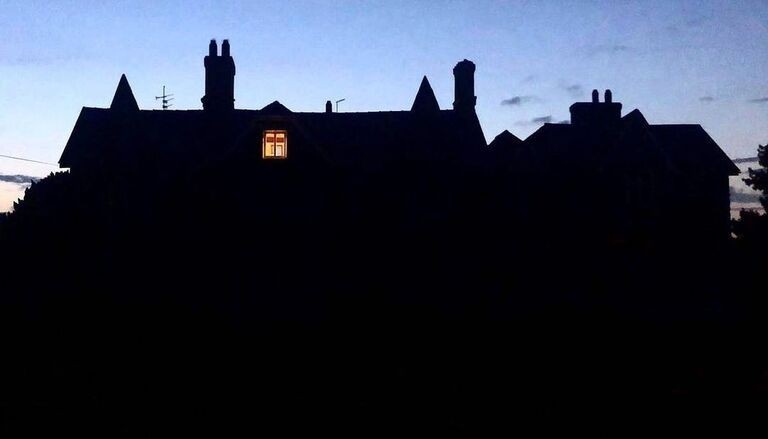
To cope with the lack of modern heating, the couple resorted to using the house's old Aga stove, a traditional feature of many older British houses. Lighting the Aga not only provided them with warmth but also connected them to a simpler, bygone way of life, enhancing the historical character of their home.
Beloved Family Home
Kathryn and Phil's journey to transform their Shropshire manor into a beloved family home was a tale of patience, perseverance, and passion. The sprawling grounds of the estate, long neglected and overgrown, now present a vibrant tapestry of colors. The once neglected flower beds are now teeming with various blooms, with lupines and foxgloves adding bright splashes of color everywhere.

Even the old rose garden has been revived under their careful care and is blooming once again. This revival of the manor's gardens is symbolic of the couple's commitment to breathing new life into every corner of their historic home, transforming what was once a forgotten space into a place of beauty and joy.
A Christmas Celebration
Even more remarkable is the transformation of the interior of the manor. Kathryn and Phil have taken on a variety of tasks, from working on old floors to repairing leaky roofs and uncovering hidden fireplaces. Their first Christmas celebration in December 2019 marked a significant milestone in their restoration journey, symbolizing the house's return to a place of warmth and celebration.
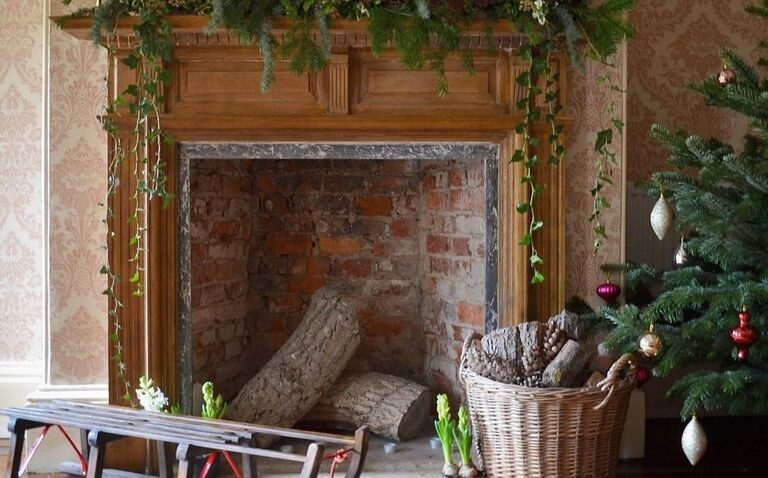
But this event was only the beginning. The project has evolved, and each new endeavor has added another layer to the rich history and character of the manor. Their commitment to restoring the property to its former glory while turning it into a functional and welcoming family home is a testament to their vision and hard work.
Evacuated
During their renovation work, Kathryn and Phil discovered fascinating insights into the manor's past. They learned that the house was turned into a school for evacuated children from Kent during World War II. This historical anecdote came to life on the 50th anniversary of Victory in Europe (V.E.) Day when former evacuees returned to the manor for a reunion.
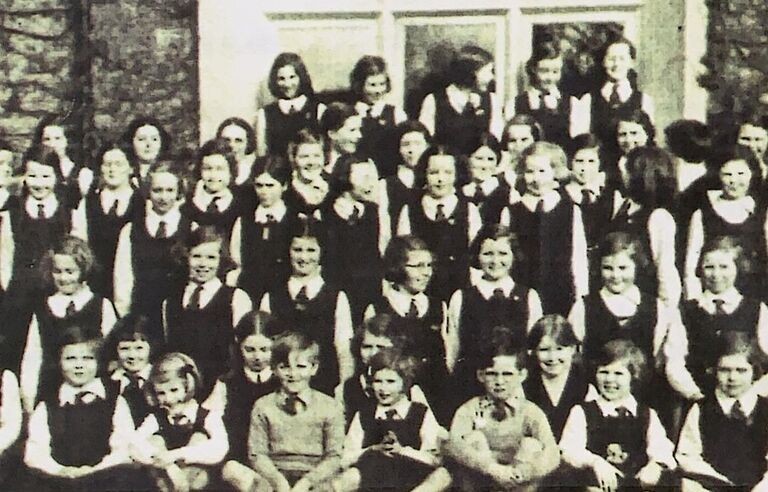
This poignant moment connected the present to the past and brought the house's wartime history into sharper focus, highlighting its role as a refuge in turbulent times.
House Staff
In one of her Instagram posts, Kathryn shared a photo of the house staff who once managed the manor, offering a glimpse into the social history of the property. The image revealed that the former owners employed a considerable number of staff, including a head butler and a gardener, to oversee the expansive estate.
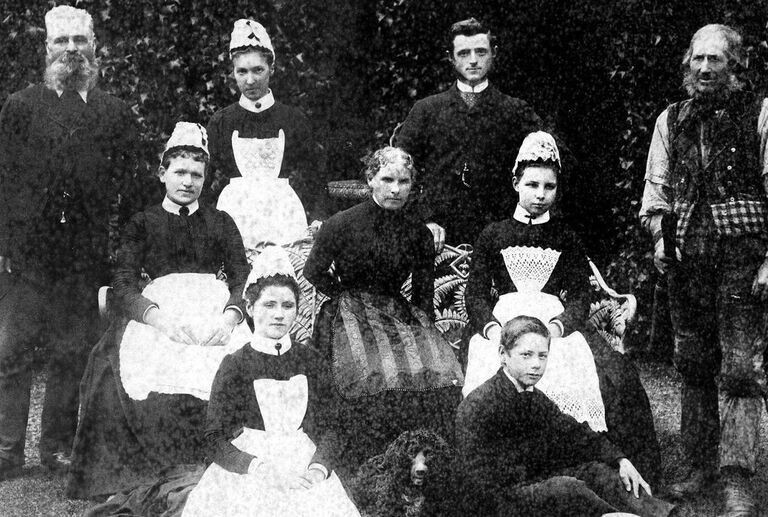
This starkly contrasts with Kathryn and Phil's own experience as they embarked on this ambitious restoration largely on their own. Their journey stands in stark contrast to the manor's past and illustrates the changing times and the evolution of such properties from supervised estates to family homes.
Letters
As part of the renovations, Kathryn made a remarkable discovery: a collection of historical letters from 1847, just two decades after the house was built. These letters, once hidden, offered an intimate glimpse into the lives of people who lived in the manor over 170 years ago.
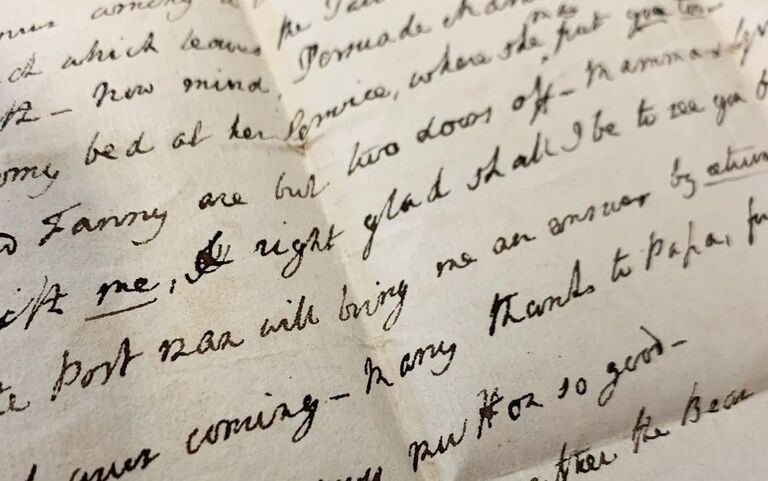
A helpful Instagram user assisted Kathryn in transcribing the intricate text, unveiling the contents of this correspondence. These letters not only added a personal dimension to the house's history but also provided insights into the daily life and social connections of its former residents.
A Strange Mystery
A peculiar letter addressed to someone named Derwas caught Kathryn's attention with its intriguing contents. The writer expressed an urgent desire for Derwas to visit, outlining travel instructions involving a carriage from the Talbot to the White Hart in Bath. However, it was the unusual closing remark of the letter that truly piqued curiosity—a request for Derwas not to bring either the bear or the monkey.
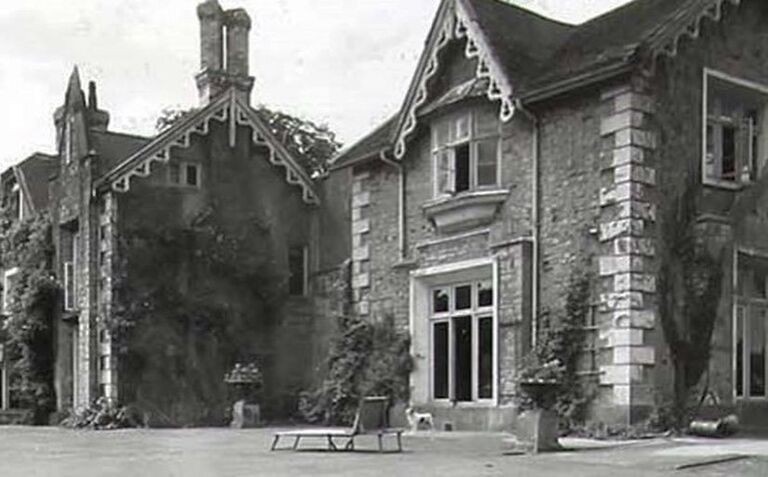
This peculiar conclusion raised questions about whether these were indeed exotic animals kept in the manor or simply endearing nicknames for something else. The mystery surrounding this hint adds an element of puzzle and whimsy to the manor's history, leaving Kathryn and her followers speculating about the true meaning behind those words.
The Bear and the Monkey
The discovery of these letters and the peculiar warning within added another layer of mystery to Kathryn and Phil's restoration journey. The mention of a bear and a monkey as potential house guests, whether meant literally or metaphorically, paints a picture of a house that has experienced a variety of unusual and fascinating episodes throughout its history.
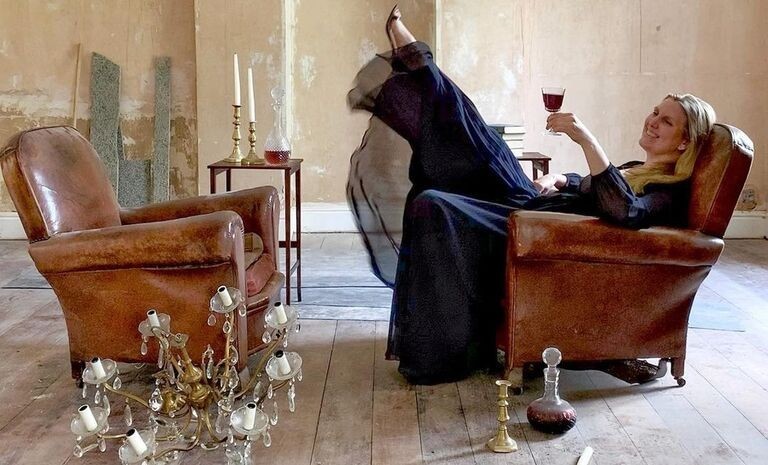
The lack of clarity surrounding this clue only deepens the mystery of the manor's past. As Kathryn herself is unsure of the exact context or meaning, the true nature of the "bear and the monkey" may remain one of the many unresolved enigmas of this historic Shropshire manor.
An Open Fire
Kathryn and Phil's renovation of the historic manor was a journey filled with unexpected discoveries, some of which are quite tangible and historically significant. One such discovery came in December 2019 when Kathryn shared a photo of a newly unveiled open fireplace, alive with dancing flames. This discovery happened rather serendipitously as she was putting up Christmas decorations. When she decided to investigate behind a barricaded area, Kathryn uncovered a Baxi Burnall, an intricate heating system.
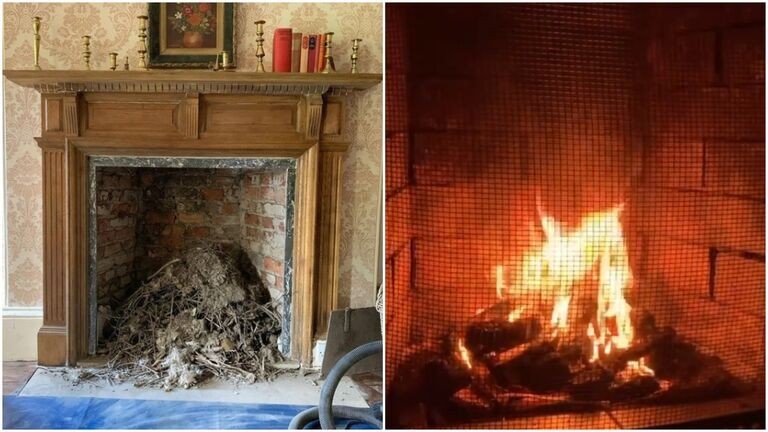
This discovery was not only a homage to the house's past but also a functional addition to their modern living space. The previously hidden Baxi Burnall was a testament to the evolving history of the house, a blend of old and new. This kind of revelation was exactly what Kathryn and Phil had hoped for when they embarked on their restoration project—to uncover and bring to light hidden elements of the house's history.
Baxi Burnall
The Baxi Burnall system, popularized in the post-World War II era, is a fascinating piece of the house's history. According to Twentieth Century Fireplaces, this system was developed in response to resource shortages and the need for efficient heating solutions for homes. The British government, seeking to promote such efficiencies, found an ally in the Baxi Burnall.
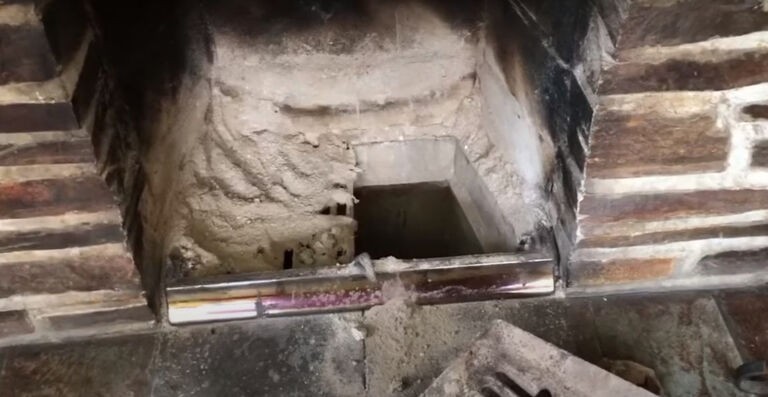
These grates, deeply set into the fireplace, draw air from beneath the floorboards to feed the fire, enabling more efficient combustion. Discovering this system in their house provided Kathryn and Phil with a direct link to the past and a practical, energy-efficient way to heat their home. It serves as a reminder of the house's evolution through different eras, adapting to the needs and technologies of the time.
A New Arrival
While some aspects of the renovation, like the fireplaces, were relatively straightforward to restore, other parts of the house required much more time and effort. Despite these challenges, Kathryn and Phil remained steadfast, driven by their commitment to restore the manor to its former glory. Their journey took a more personal turn in February 2021 with the arrival of their daughter, Minnie.
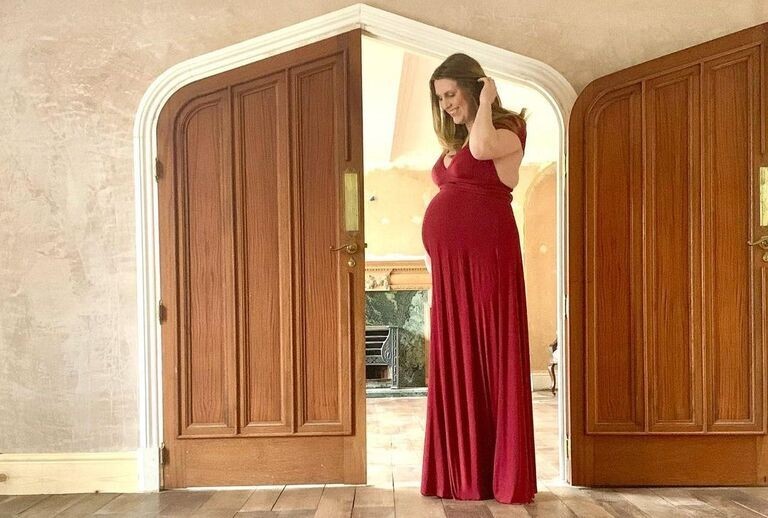
This new addition to their family gave their project added significance as they were not just restoring a house but creating a home for their growing family. Minnie's arrival marked a new chapter in their lives and in the life of the house, transforming it from a mere structure into a warm, loving home.
Salon
Today, the transformation of the manor in Shropshire is becoming more apparent. One of the most remarkable achievements is the restoration of the oak floor in the drawing-room. Hidden under carpets for decades, the floor was meticulously sanded, polished, and brought to a high gloss to reveal its original beauty and craftsmanship.
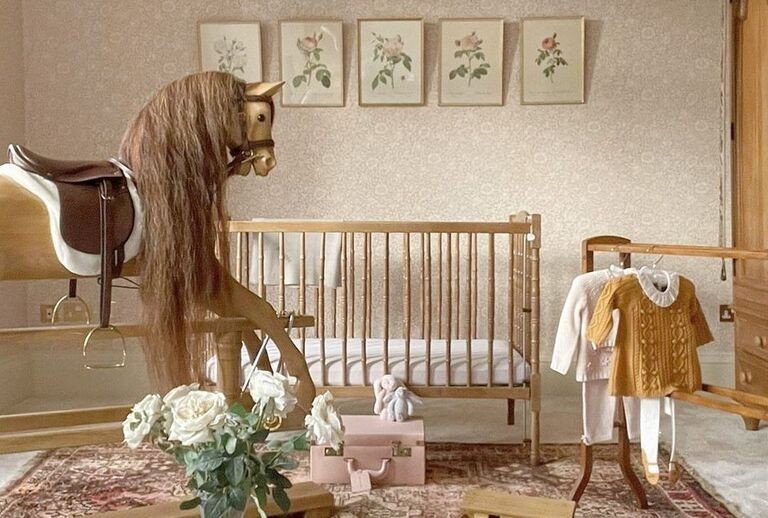
This restoration work symbolizes Kathryn and Phil's commitment to preserving the historical integrity of the house while making it suitable for modern living. The drawing-room, once a symbol of the house's decay, now stands as a testament to the couple's hard work and vision—a space where past and present harmoniously coexist.
61 Rooms
Upstairs in the house, Kathryn and Phil lovingly set up a nursery for Minnie. This room, furnished with bespoke furniture and a vintage rocking horse, is more than just a room; it is a reflection of their hopes and dreams for their daughter's future.
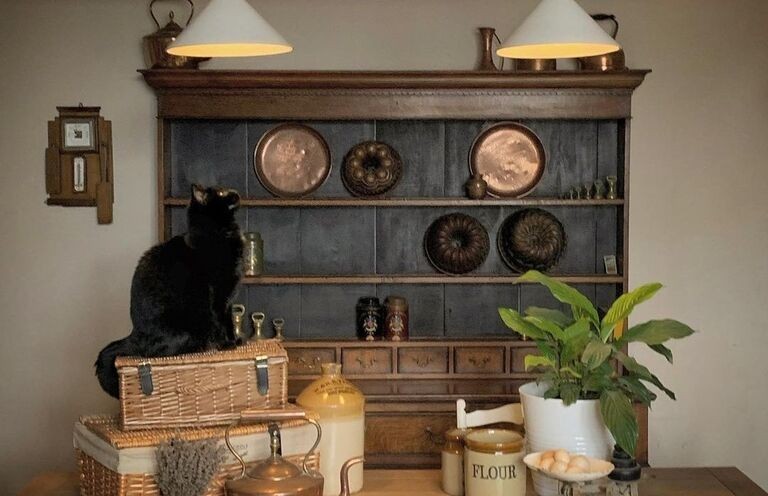
However, with 61 rooms and an extensive estate, their restoration project is far from complete. The magnitude of the task is daunting, yet the couple remains undaunted, driven by their love for the house and their desire to fully restore it.
Instagram Success
By August 2021, Kathryn and Phil's Instagram account @totheshireborn had attracted over 65,000 followers. Their honest portrayal of the renovation process, including its challenges and triumphs, has reached a wide audience.
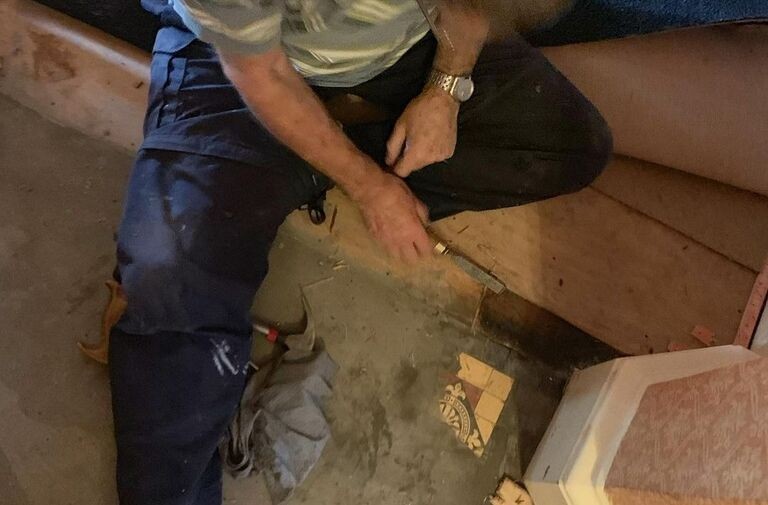
Followers are drawn to the authenticity of their journey, witnessing the transformation of a neglected manor into a stunning family home. The couple's story is not just about renovation; it is about perseverance, history, and the creation of a legacy.
"I'm not quite sure what prompted me to..."
One of the most captivating moments of their journey occurred on September 8, 2019 when Kathryn posted a fascinating photo on Instagram. The couple had spontaneously decided to remove the carpet in their hallway, which would turn into one of the significant projects in the house.
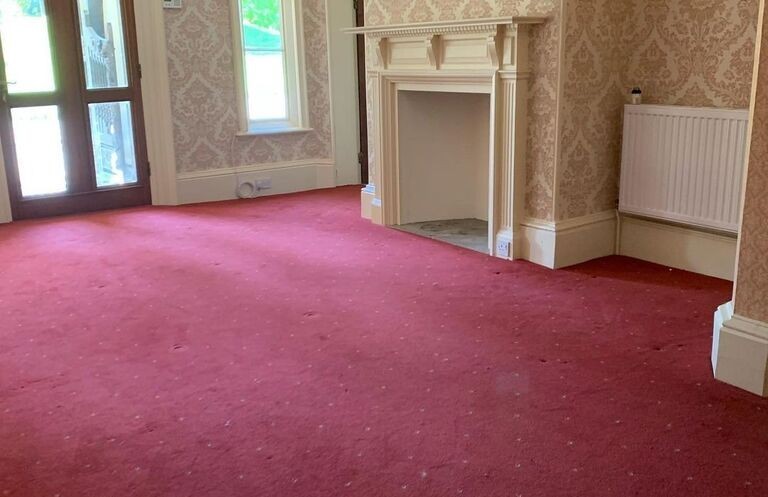
Kathryn's caption, describing her spontaneous decision to explore the floors amidst numerous ongoing tasks, captured the essence of her adventure. This unplanned exploration led to a stunning discovery and added another layer to the rich history of the manor. The photo and the accompanying narrative intrigued their followers, eager to discover what hidden secrets the house had yet to reveal.
An Old Carpet
Kathryn and Phil's decision to remove the aging carpet in their hallway marked a turning point in their renovation. The space itself was a grand area characterized by a magnificent spiral staircase and expansive arches that created an atmosphere of elegance and history. However, the bright red carpet covering the floor contrasted with the couple's aesthetic preferences and the historical character of the house.
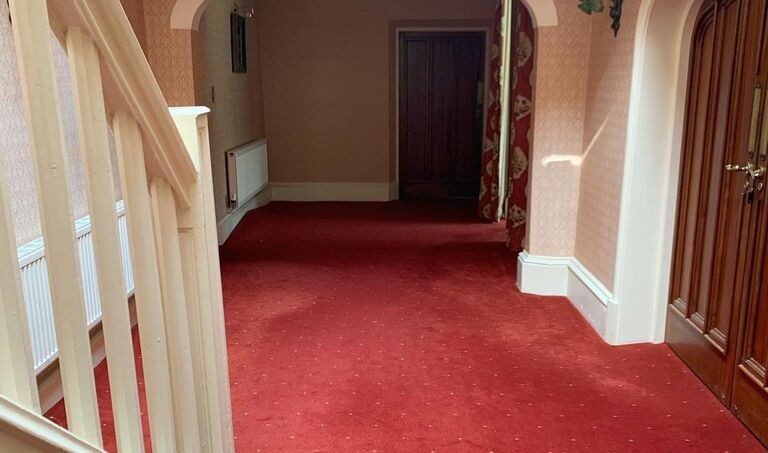
They realized that this flooring, likely a product of a much later era, did not align with their vision of restoring the house's original charm. The vivid and modern carpet sharply contrasted with the room's subtler and more sophisticated architectural elements, prompting the couple to explore what lay beneath.
Not the First Glimpse
Kathryn recalled that this was not their first attempt to unveil the secrets under the carpet. She shared on Instagram how they had lifted a corner of the carpet upon moving in, only to find a concrete-like surface underneath.
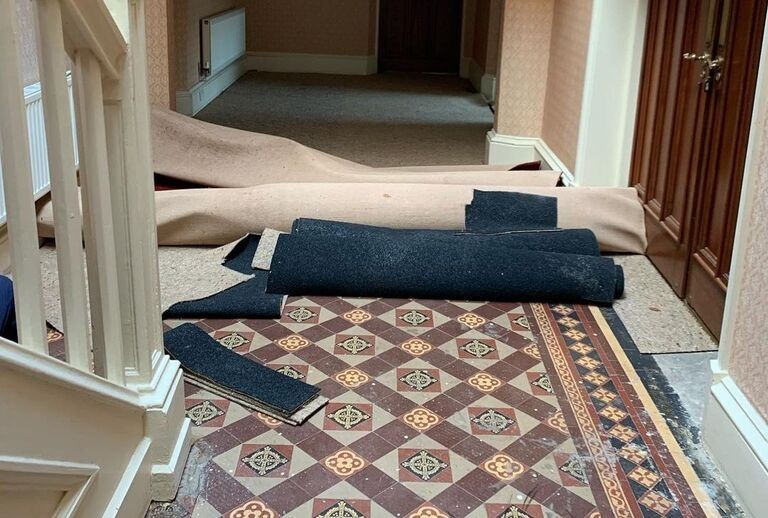
At the time, they decided to leave the carpet in place, intending to remove it later when they would start decorating that area of the house. However, this initial glimpse revealed little about the true nature of what lay beneath and led them to temporarily halt their exploration.
The Second Peek
Eventually, driven by curiosity and the ongoing restoration process, Kathryn and Phil decided to look under the carpet again, this time at a different spot. To their amazement, they discovered a beautifully crafted tiled floor.
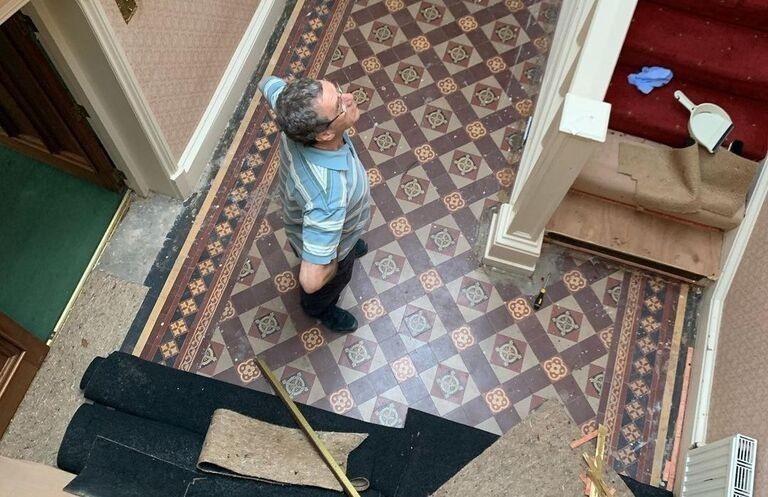
This hidden gem, undisturbed under the outmoded carpet, was a revelation. The age of the tiles, coupled with their remarkable preservation, made this find particularly special. It was a window into the past, offering a glimpse into the original elegance that once defined this space.
A Beautiful Design
Once the floor was fully exposed, Kathryn was overwhelmed by the beauty that had been hidden for so long. The couple worked tirelessly to uncover the entire breathtaking tile design.
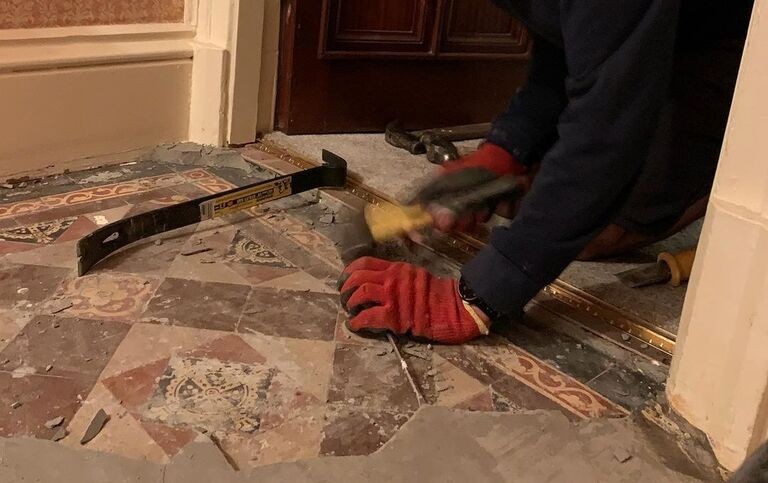
The geometric pattern of the tiles with shades of red, black, and gold stretched across the entire hallway, transforming it from a simple passageway into a showcase of historical artistry. This discovery underscored the hidden potential lying within their house, ready to be rediscovered and reappreciated.
Hypnotic
The tile design, with its intricate geometric patterns and elegant floral and cross motifs in black and gold, captivated Kathryn and Phil. As they realized the significance of their find, they were determined to restore the floor to its original splendor.
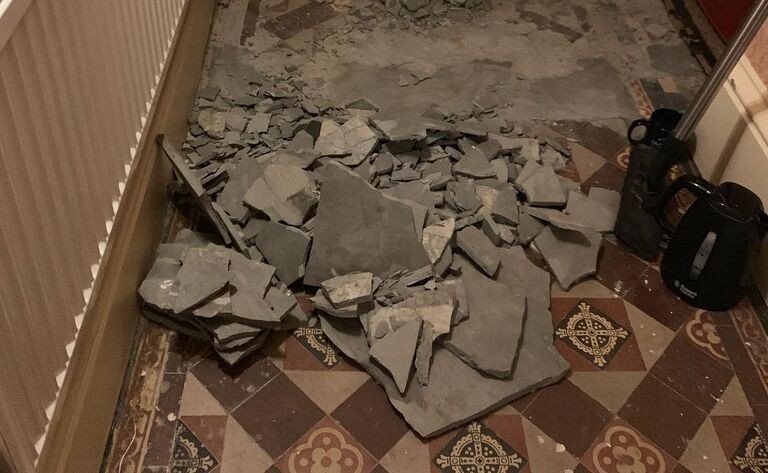
However, they knew this task would be challenging and required careful and meticulous work to preserve the integrity and beauty of the tiles. This part of the renovation was not just about repairs; it was about reverence and reviving a piece of the house's history.
"It's amazing"
Kathryn shared before-and-after pictures on Instagram, highlighting the dramatic transformation of the hallway. The contrast between the old, covered floor and the newly uncovered tile masterpiece was striking.
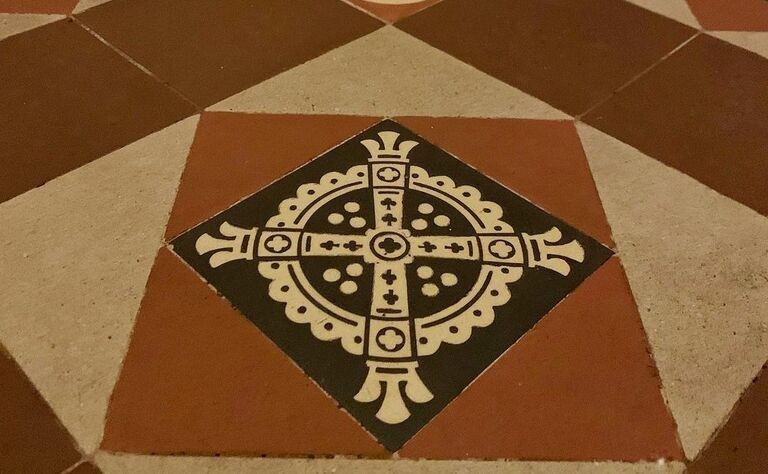
However, the process of revealing the tiles was not simple. The floor was littered with remnants of glue, underlay, carpet grippers, and areas of leveling compound, all of which had to be carefully removed to not damage the historic tiles underneath.
TikTok
In a TikTok video, Kathryn and Phil showcased the labor-intensive process associated with uncovering the tiles. Removing the leveling compound was particularly arduous, requiring hours of careful work. Once the carpet and compound were removed, they meticulously cleaned the tiles, unveiling their full beauty.
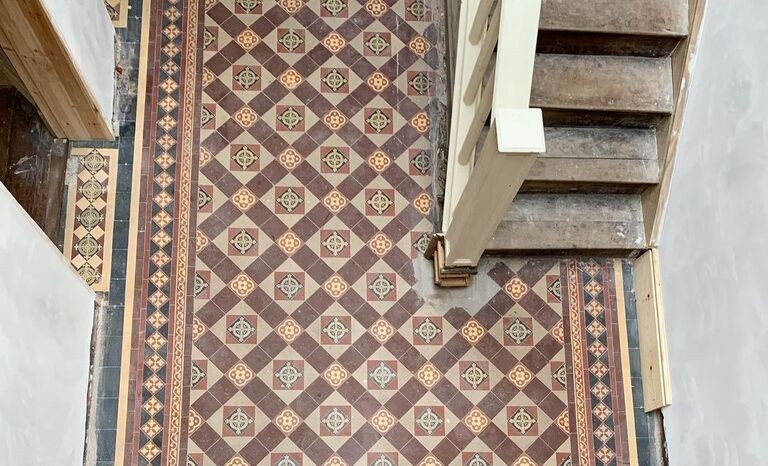
This video not only highlighted the challenges of restoration but also the couple's dedication to preserving and showcasing the historic features of the manor. Contemplating the upcoming restoration process, they were aware that it would be a long and meticulous endeavor that would ultimately restore a piece of the house's soul.
Becoming Detectives
Restoring the broken and missing tiles in their hallway posed a challenge that required patience and detective work from Kathryn and Phil. Kathryn embarked on a quest to find the original manufacturers of these exquisite tiles and discovered that they were made by Maw & Co., a renowned local company specializing in ceramic tiles. Maw & Co. used a method known as encaustic painting, a traditional technique involving creating designs with various colored clays.
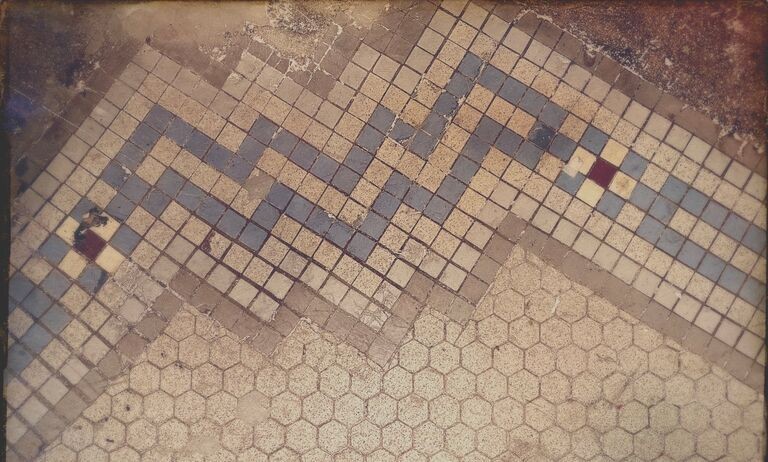
This discovery was crucial as it provided insights into the origin of the tiles and the specific method of their production. The encaustic tiles with their vibrant patterns and colors were not just decorative elements; they were artworks reflecting the craftsmanship and artistic skills of the Victorian era. Finding the original manufacturers was a significant step in authentically restoring the tiles and preserving a piece of the house's history.
Encaustic Tiles
Encaustic tiles have a rich history dating back to the Middle Ages. They were initially used to add color and detail to the interiors of monasteries and cathedrals, enlivening otherwise plain spaces. The technique involved pressing layers of differently colored clays to create complex patterns and designs.
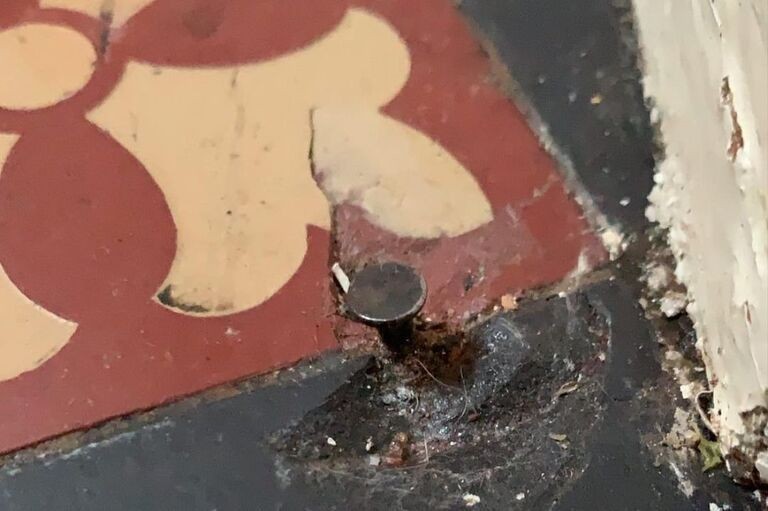
This tile-making method saw a revival during the Victorian era, especially during the Gothic Revival architectural movement. The resurgence of this ancient art form was not just a matter of aesthetics; it was a homage to a bygone era, a way for Victorians to connect with their historical roots. Wealthy individuals of the time were particularly drawn to these tiles, seeing them as a means to showcase their status and appreciation for historical artistry.
A More Affordable Alternative
Victorian manufacturers responded to the growing demand for encaustic tiles by finding ways to produce them more efficiently. The process, however, remained time-consuming and costly, making these tiles a luxury item affordable only to the affluent. To make the tiles more accessible, manufacturers devised an alternative approach—creating monochromatic designs that could be arranged in geometric patterns.
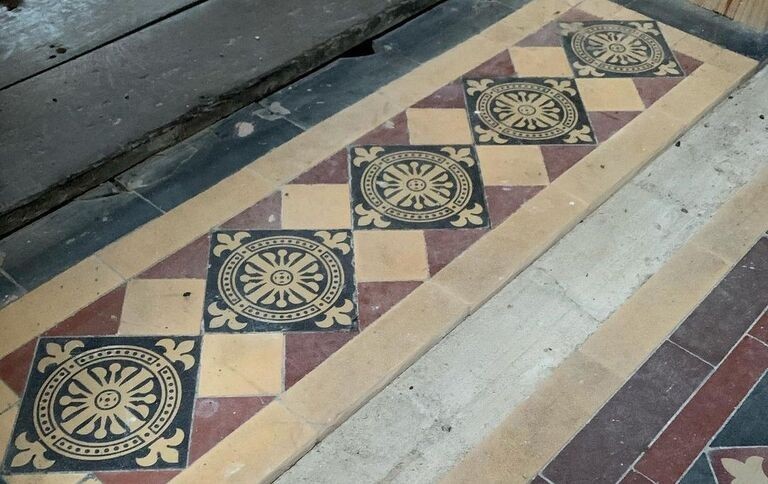
This innovation made the tiles more affordable and widespread, leading to their popularity in Victorian homes. The geometric patterns, though simpler than the original encaustic designs, still offered homeowners the opportunity to bring elegance and style into their interiors.
The Real Deal
The Industrial Revolution played a crucial role in popularizing geometric tiles in Victorian England. New manufacturing techniques made these tiles a common feature in many homes of that era. The discovery of genuine encaustic tiles in Kathryn and Phil's house suggests that the house once belonged to someone of considerable wealth and taste.
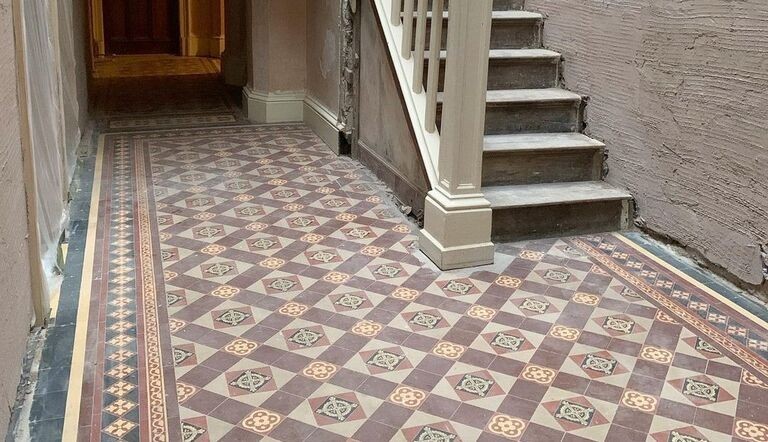
The tiles represent not just a design choice but also a statement of status and appreciation for the craftsmanship of the time. This discovery adds another layer to the house's history, revealing clues about its past inhabitants and their lifestyle.
Learning More
In July 2021, Kathryn shared more details about the tiled floor on Instagram. Through her research, she learned that the tiles were likely laid around 1860 when they were at the height of their popularity. This period was marked by a great interest in reviving historical styles and integrating them into modern homes. Fortunately, the couple did not find any asbestos in the tiles, a common hazard in renovating older properties.
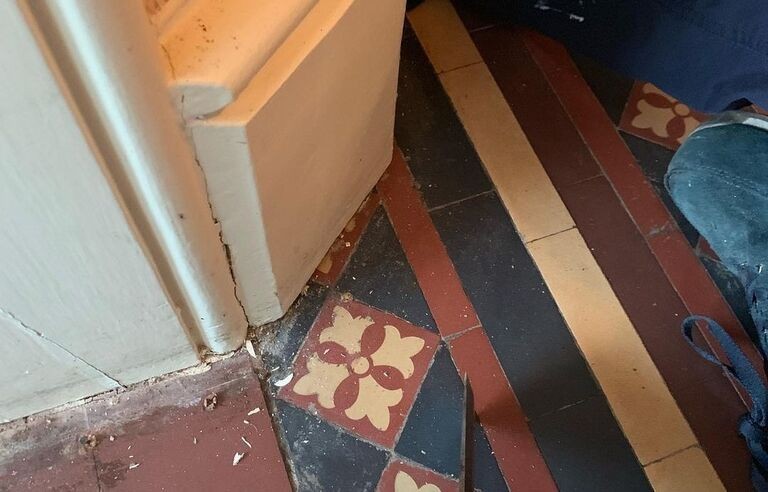
The absence of asbestos meant that they could continue their restoration work without extensive safety precautions. Kathryn's research into the history and context of the tiles not only informed their restoration process but also deepened her connection to the house's past.
Disappearing Tiles
However, the mystery of the tiles extended beyond their origin and production. As Kathryn and Phil examined the floor more closely, they noticed that parts of the design ran under the skirting boards. This observation suggested that the layout of the hallway had been altered over time. The original design of the hallway, now partially concealed, offered clues about how the house was used and experienced by its previous residents.
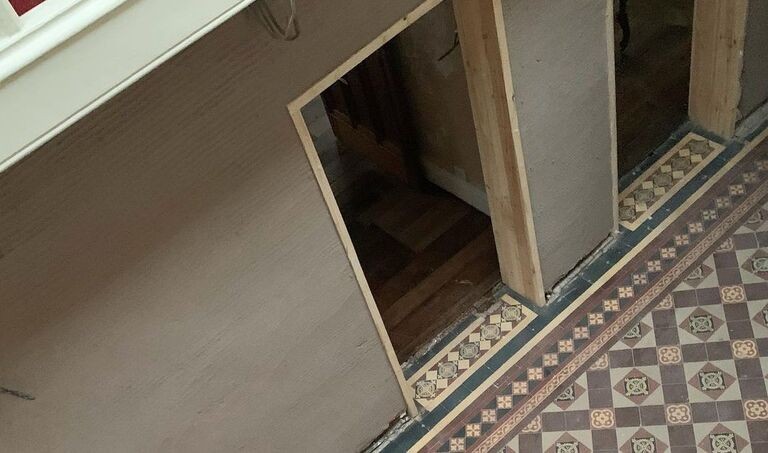
This discovery prompted Kathryn and Phil to ponder the evolution of the interior of their house over the decades and consider how best to preserve its architectural integrity.
Almost Finished
Kathryn suspected that during renovations in the 1960s, the arrangement of the rooms branching off from the hallway was altered. The originally separate doors were replaced by a single, larger entrance, reflecting a trend towards more open living spaces. However, Kathryn and Phil decided to undo these changes and restore the hallway to its original state.
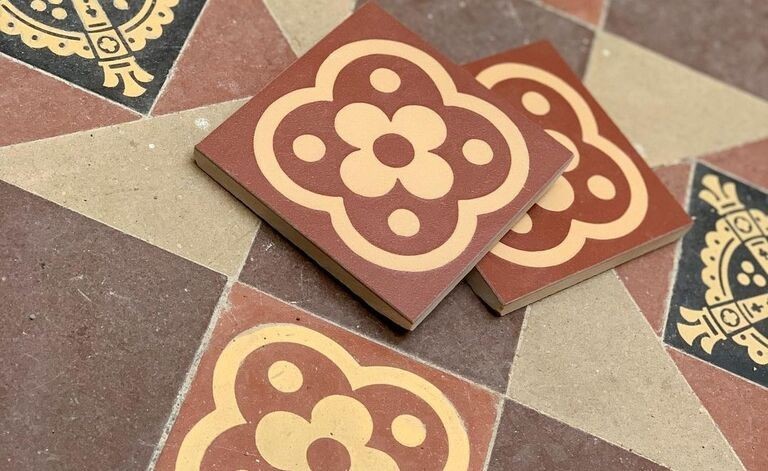
By July 2021, their efforts to renovate this part of the house were nearing completion. Their commitment to restoring the hallway's original design, including repairing the tiled floor, was a testament to their dedication to preserving the house's historic character. Their meticulous restoration work not only brought the tiles back to life but also established a connection to the architectural heritage of the house.
Replacement Tiles
The story of how Kathryn and Phil found replacement tiles for their Victorian floor was as unique as the discovery itself. Maw & Co., the original manufacturers of the tiles, ceased operations in 1970 only to reopen more than three decades later, in 2001. However, the couple did not have to reach out to the revived company for replacements. In an unexpected turn, another Instagram user, moved by their story, generously offered the needed tiles.
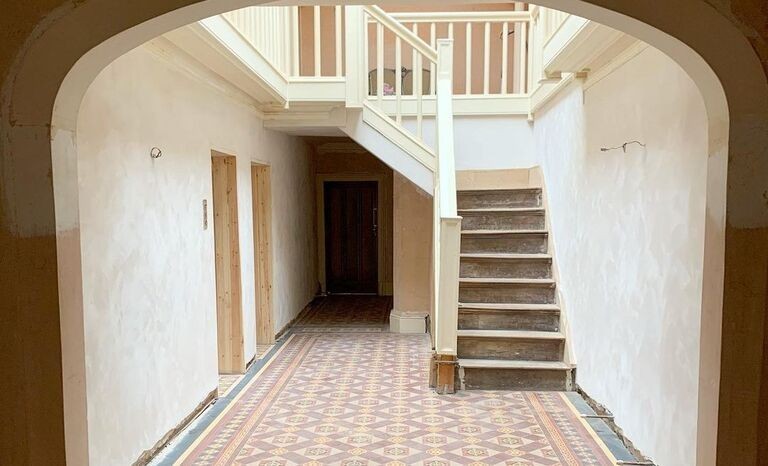
This act of kindness not only saved them the trouble of seeking out a manufacturer but also highlighted the sense of community and shared interest in historical preservation that can be fostered through social media. The tiles, once just a detail in a grand house, had now become a symbol of connection and collaboration, linking Kathryn and Phil to a network of people who shared their passion for restoration.
Viral Success
By July 10, 2021, the restoration of the hallway was nearing completion, as Kathryn shared in an Instagram post. The journey from discovering the hidden tiles to their restoration was a labor of love, with only a final cleaning remaining. However, the story had taken on a life of its own beyond the borders of their house.
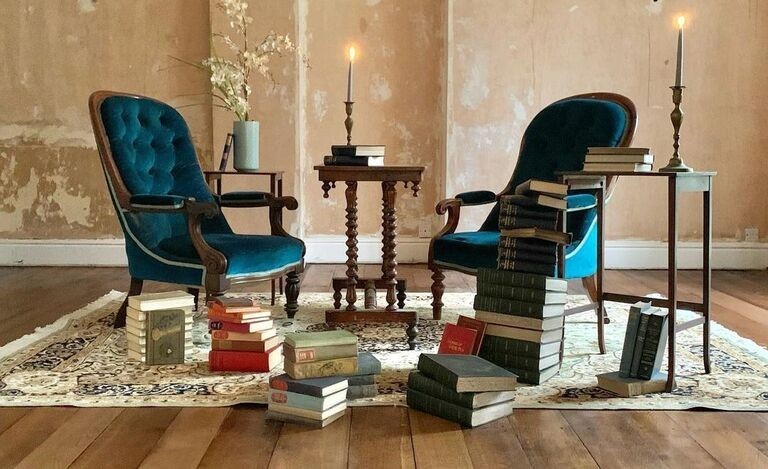
One of their videos showcasing the tiles went viral, reaching over 18 million views. This unexpected attention thrust their renovation project into the spotlight, captivating an audience far beyond their initial expectations. The viral success of the video not only highlighted the beauty of their discovery but also showcased the power of social media to share and celebrate heritage and history.
What's Next?
The surge in popularity of their Instagram account @totheshireborn was evidence of public interest in their restoration journey. With thousands of followers now eagerly tracking their progress, Kathryn and Phil had unwittingly become ambassadors for the restoration of historical houses.
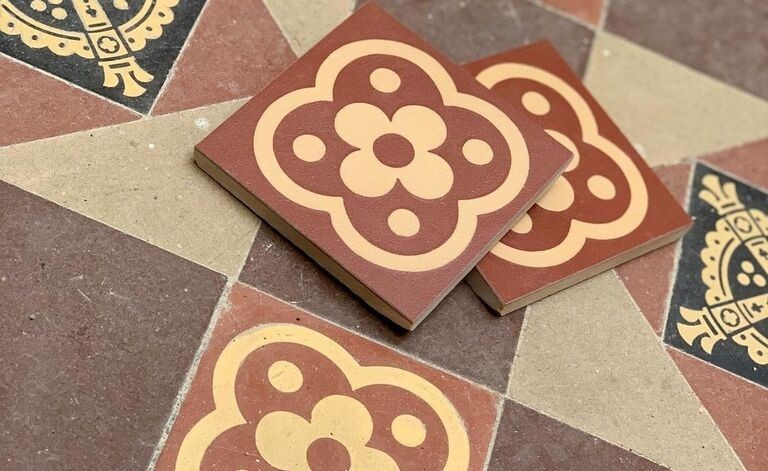
By August 2021, they were on the verge of putting the finishing touches on their now famous entrance area, transforming it into a showpiece that paid homage to its Victorian past while welcoming visitors into their modern home. This stage of the project was more than just a renovation; it was a celebration of the house's history, invigorated by the couple's commitment and the support of their growing online community.
When One Door Closes, Another Opens
At the same time, Kathryn and Phil expanded their restoration efforts to the exterior of their Shropshire manor. Kathryns' post on August 17, 2021, hinted at ongoing discoveries and challenges.
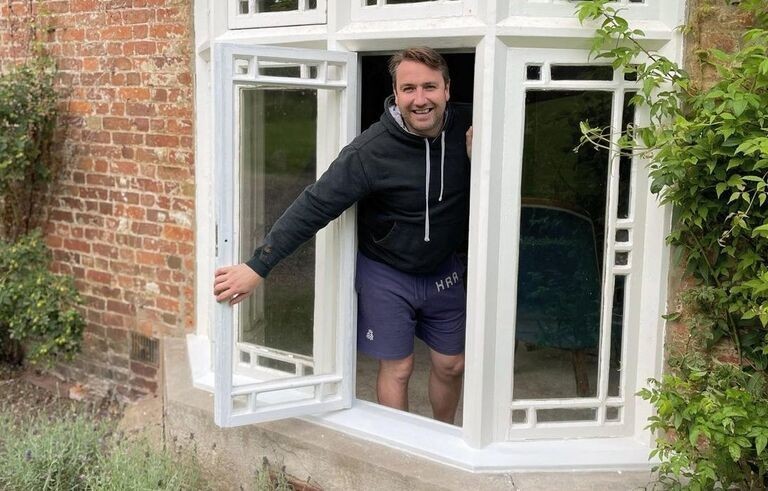
"When one door closes, another one opens." This phrase aptly described their experience as they uncovered more hidden architectural features, including possibly bricked-up doors.
An Unexpected Journey
Looking back on their journey since 2018, Kathryn and Phil were likely amazed by the unexpected turns their renovation project had taken. What began as a mission to restore a grand Victorian estate had evolved into an adventure full of surprising discoveries, like the hidden tiled floor beneath their hallway carpet. The journey was transformative, not just for the house but for the couple themselves.
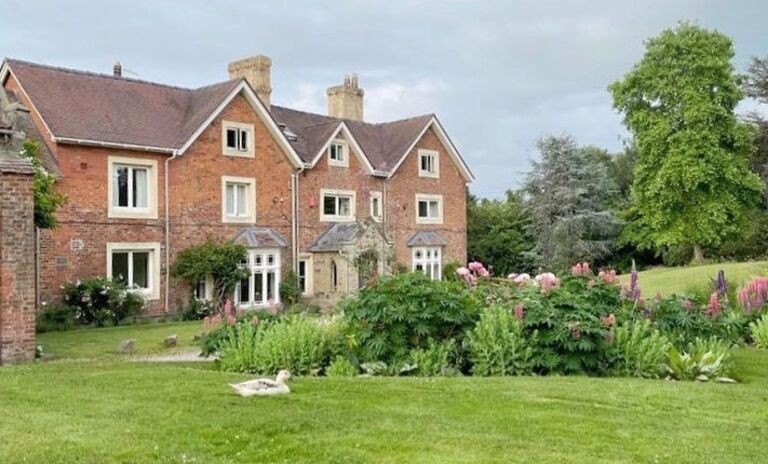
As they continued their work, there was a sense of anticipation and excitement about what other secrets the house might hold. Every corner of the manor held the potential for new discoveries, every room a story waiting to be told. Their experience underscored the idea that in the world of historical restoration, the past is always present, and each renovation can lead to a new revelation.










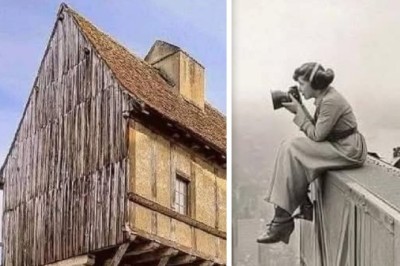









Comments
0 comment